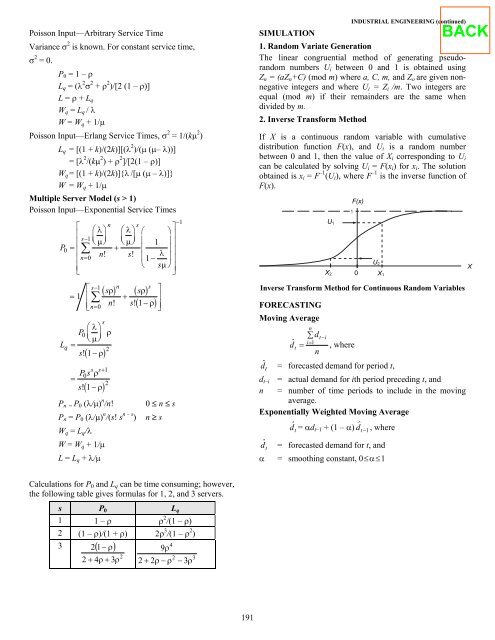fundamentals of engineering supplied-reference handbook - Ventech!
fundamentals of engineering supplied-reference handbook - Ventech!
fundamentals of engineering supplied-reference handbook - Ventech!
You also want an ePaper? Increase the reach of your titles
YUMPU automatically turns print PDFs into web optimized ePapers that Google loves.
Poisson Input—Arbitrary Service Time<br />
Variance σ 2 is known. For constant service time,<br />
σ 2 = 0.<br />
P0 = 1 – ρ<br />
Lq = (λ 2 σ 2 + ρ 2 )/[2 (1 – ρ)]<br />
L = ρ + Lq<br />
Wq = Lq / λ<br />
W = Wq + 1/µ<br />
Poisson Input—Erlang Service Times, σ 2 = 1/(kµ 2 )<br />
Lq = [(1 + k)/(2k)][(λ 2 )/(µ (µ– λ))]<br />
= [λ 2 /(kµ 2 ) + ρ 2 ]/[2(1 – ρ)]<br />
Wq = [(1 + k)/(2k)]{λ /[µ (µ – λ)]}<br />
W = Wq + 1/µ<br />
Multiple Server Model (s > 1)<br />
Poisson Input—Exponential Service Times<br />
⎡ n s<br />
⎛λ⎞ ⎛λ⎞ ⎤<br />
⎢<br />
⎛ ⎞<br />
s−1<br />
⎜ ⎟ ⎜ ⎟ ⎥<br />
⎢ ⎝µ⎠ ⎝µ⎠ ⎜ 1 ⎟⎥<br />
P0<br />
= ⎢∑+ ⎜ ⎟<br />
n=<br />
0 n! s!<br />
λ ⎥<br />
⎢ ⎜1−⎟⎥ ⎢ ⎝ sµ⎠<br />
⎣<br />
⎥<br />
⎦<br />
L<br />
q<br />
s−1<br />
n s<br />
( sρ) ( sρ)<br />
∑ n! s!1<br />
( −ρ)<br />
⎡ ⎤<br />
= 1 ⎢ + ⎥<br />
⎢ ⎥<br />
⎣n= 0<br />
⎦<br />
⎛λ⎞ P0<br />
⎜<br />
⎝µ⎠<br />
⎟<br />
=<br />
s!1<br />
Ps<br />
=<br />
s!1<br />
s<br />
( −ρ)<br />
( −ρ)<br />
ρ<br />
2<br />
s s+<br />
1<br />
0 ρ<br />
2<br />
Pn = P0 (λ/µ) n /n! 0 ≤ n ≤ s<br />
Pn = P0 (λ/µ) n /(s! s n – s ) n ≥ s<br />
Wq = Lq/λ<br />
W = Wq + 1/µ<br />
L = Lq + λ/µ<br />
Calculations for P0 and Lq can be time consuming; however,<br />
the following table gives formulas for 1, 2, and 3 servers.<br />
−1<br />
s P0 Lq<br />
1 1 – ρ ρ 2 /(1 – ρ)<br />
2 (1 – ρ)/(1 + ρ) 2ρ 3 /(1 – ρ 2 )<br />
3 2(<br />
1−<br />
ρ)<br />
2<br />
2 + 4ρ<br />
+ 3ρ<br />
4<br />
9ρ<br />
2 3<br />
2 + 2ρ<br />
− ρ − 3ρ<br />
191<br />
INDUSTRIAL ENGINEERING (continued)<br />
SIMULATION<br />
1. Random Variate Generation<br />
The linear congruential method <strong>of</strong> generating pseudorandom<br />
numbers Ui between 0 and 1 is obtained using<br />
Zn = (aZn+C) (mod m) where a, C, m, and Zo are given nonnegative<br />
integers and where Ui = Zi /m. Two integers are<br />
equal (mod m) if their remainders are the same when<br />
divided by m.<br />
2. Inverse Transform Method<br />
If X is a continuous random variable with cumulative<br />
distribution function F(x), and Ui is a random number<br />
between 0 and 1, then the value <strong>of</strong> Xi corresponding to Ui<br />
can be calculated by solving Ui = F(xi) for xi. The solution<br />
obtained is xi = F –1 (Ui), where F –1 is the inverse function <strong>of</strong><br />
F(x).<br />
U1 U1<br />
F(x)<br />
1<br />
U2<br />
U2<br />
X2 X1<br />
X2<br />
Inverse Transform Method for Continuous Random Variables<br />
FORECASTING<br />
Moving Average<br />
n<br />
X2 0<br />
d<br />
d<br />
n<br />
ˆ<br />
∑ t i<br />
i<br />
t = =<br />
−<br />
1 , where<br />
d ˆ<br />
t = forecasted demand for period t,<br />
dt–i = actual demand for ith period preceding t, and<br />
n = number <strong>of</strong> time periods to include in the moving<br />
average.<br />
Exponentially Weighted Moving Average<br />
dt ˆ = αdt–1 + (1 – α) dt 1<br />
ˆ , where<br />
dt ˆ = forecasted demand for t, and<br />
α = smoothing constant, 0≤α≤1<br />
−<br />
X X
















